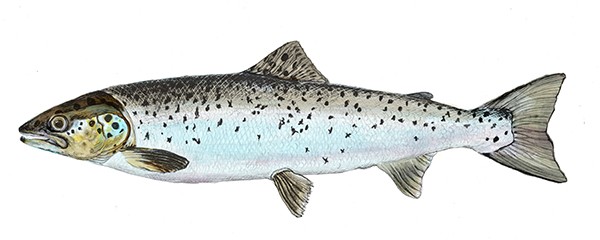Home → Fish & Wildlife → Fisheries → Species Information → Landlocked Salmon
Landlocked Salmon

Common Name: Landlocked Atlantic Salmon
Other Names: Sebago Salmon, Quananiche
Scientific Name: Salmo salar sebago
Origin: Native
Adult Size: Average size is 16-18 inches and 1-1 1/2 pounds, but 3-5 pound fish are not uncommon.
Identification: Adults are generally silvery with a slightly forked tail and small X-shaped markings on the back and upper sides. Juvenile salmon have a dark red spot between each pair of parr marks. Mature males develop a "kype", or hooked jaw, during the spawning season.
Diet: Rainbow smelts are the principal forage for landlocked salmon in Maine lakes. Landlocked salmon growth can be poor without adequate numbers of smelts. Maintaining adequate numbers of smelts for forage is the most important part of managing landlocked salmon in Maine.
Fishing Tips:
Landlocked salmon are an entertaining fish to catch. Once hooked, a landlocked salmon almost always lives up to their nickname, “leaping landlocked.” Acrobatic jumps and deep, strong dives are commonplace, with anglers often reaching for their drag to control the fish.
A coldwater fish, landlocked salmon prefer water temperatures below 65 degrees and rely on smelt to thrive.
During the spring and fall, you are likely to find them feeding near the surface and close to shore, and can catch them by fly fishing, casting, or trolling with lures or bait. Streamer flies and lures resembling smelt are very effective.
In the warmer summer months of June, July, and August, they generally descend to depths of 30 to 60 feet. When landlocked salmon are deep, the best method to catch them is trolling with lead core line or a downrigger, using copper, gold, or silver lures. Fly-casting can be productive in lakes during insect hatches and is the preferred method for catching landlocked salmon in rivers. Fly anglers targeting rivers are successful with dry flies, nymphs, and streamers.
Ice fishing for landlocked salmon in the winter can also be quite productive using smelts or other bait, dead or alive. Ice anglers also have luck utilizing jigs. Landlocked salmon are frequently caught “under the ice” and should be targeted within the first 15 feet below the ice.
Interesting Facts:
- The oldest landlocked salmon on record in Maine was 13 years old.
- Landlocked salmon are a freshwater form of the sea-run Atlantic salmon.
- Landlocked salmon provide great entertainment when caught with their frequent acrobatic jumps out of the water.
Management:
Prior to 1868, landlocked salmon populations occurred in only four river basins in Maine: the St. Croix, including West Grand Lake in Washington County; the Union, including Green Lake in Hancock County; the Penobscot, including Sebec Lake in Piscataquis County; and the Presumpscot, including Sebago Lake in Cumberland County.
Cathance Lake in Washington County was likely the first Maine lake to be stocked with landlocked salmon. This occurred in 1868 using landlocked salmon eggs obtained at Grand Lake Stream the previous year.
Maine now supports one of the largest sport fisheries for this species in the world. Landlocked salmon provide a fishery in over 300 lakes and approximately 320 miles of rivers and streams in the State. Natural reproduction supports wild landlocked salmon fisheries in many lakes where sufficient spawning and nursery habitat are present. A majority of these waters are located in western and northern Maine.
In waters lacking adequate spawning and nursery habitat to produce wild landlocked salmon, MDIFW stocks them to maintain a fishery. Without regular stockings, landlocked salmon in these lakes would disappear or their numbers would be too low to provide a fishery that anglers would enjoy.
Wild landlocked salmon spawn in lake outlets or inlets from mid-October to late November. Eggs are buried in gravel from 4 to 12 inches deep and remain there until hatching early the following spring. Young wild landlocked salmon spend one to four years in a stream environment prior to migrating to a lake. Recent studies in Maine show most wild landlocked salmon (about 75%) spend two years as stream dwellers.
In wild landlocked salmon populations, males usually spawn for the first time when they are three or four years old. Females usually spawn for the first time at ages four and five.
Landlocked Salmon may spawn more than once, but most observed on spawning runs are spawning for their first time. Landlocked salmon may spawn in consecutive or alternate years; some may spawn in consecutive years then skip a year; and some may skip 2 or 3 years between spawnings. Food abundance, water levels, water temperatures, and other factors can influence spawning rates.
Extensive studies conducted in Maine clearly show that landlocked salmon growth rates, and consequently the size of fish available to anglers, is best in lakes that have excellent water quality and do not have large populations of other fish competing for smelt such as togue.
While "catch and release" of landlocked salmon has improved fishing in some lakes, it has negatively impacted smelt populations in others, resulting in more numerous and smaller landlocked salmon. MDIFW fishery biologists often reduce the number of landlocked salmon stocked or adjust fishing regulations, often in the form of encouraging harvest, to restore the balance between smelts and landlocked salmon.
Sea-run Atlantic Salmon
Unlike the landlocked form, sea-run Atlantic salmon do not complete their life cycle solely in freshwater. These anadromous fish spawn in Maine’s rivers and streams and their young spend one to three years in freshwater before migrating to saltwater to grow into adults. After maturing in saltwater, they return to the stream in which they were born to repeat the cycle. Gulf of Maine Atlantic Salmon are a federally endangered species. It is illegal to fish for or possess wild sea-run Atlantic salmon. The General Fishing Laws for landlocked salmon in rivers and streams include a 25” maximum length limit to protect returning sea-run adults from accidental harvest (average size of sea-run adults is >25”).